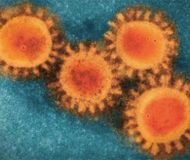

A study led by Dr. Pere Domingo, coordinator of the HIV and AIDS Research Group and hospitalization COVID of the Sant Pau Research Institute -IIB Sant Pau and member of the Infectious Diseases Unit of the Hospital de Sant Pau analyzes the pathogenesis of COVID -19 as the dynamic interaction between four circles that occur simultaneously. One more step to understand the mechanism that the virus uses to bypass the host’s immune defense mechanisms, or the mechanisms it uses to harm, and that will allow designing appropriate strategies to neutralize the dysfunctions or imbalances generated by the virus or by the consequences of the infection.
The pathogenesis of coronavirus disease 2019 (COVID-19) can be conceived as the dynamic interaction between four vicious circles that feed each other and that are linked or that occur simultaneously. These are the viral circle, the hyperinflammatory circle, the circle of the non-canonical axis of the renin-angiotensin system (SRA) and the circle of hypercoagulation, according to the study “The four horsemen of a viral Apocalypse: The pathogenesis of SARS-CoV2 infection (COVID-19) ”. This study, led by Dr. Pere Domingo, coordinator of the HIV and AIDS Research Group and the Hospitalization COVID of the l’Institut de Recerca de Sant Pau –IIB Sant Pau and member of the Infectious Diseases Unit of Hospital de la Santa Creu i Sant Pau, has recently been published in the prestigious EBioMedicine.
The virus is a necessary cause that generates cellular damage and sets in motion a hyperinflammatory response, while causing or delaying the antiviral defense and the entire anti-inflammatory defense mechanism of the lung. The study analyzes the mechanisms of the virus -and host- dependent that can end up in the severe acute respiratory syndrome (SARS) due to coronavirus (CoV) -2, infecting alveolar epithelial cells (CEA) and reducing the axis of the angiotensin-converting enzyme 2 (ECA2) / angiotensin (Ang) – (1-7) / Mas1R with the interaction of the four circles. And it reviews what we know so far about the pathogenesis of COVID-19 and how SARS-CoV-2 infection and host response describe the different scenarios of COVID-19, envisioning four interlocking vicious circles:
• The retroactive viral circle includes evasion of the host’s innate response, uncontrolled viral replication, and activation of an overactive adaptive immune response that assumes that the virus can multiply without hindrance.
• The hyperinflammatory circle is formed by an exuberant inflammatory response that feeds back until it triggers a true storm of cytokines that affect various organs, but especially the lung.
• The circle of the non-canonical axis of the renin-angiotensin system (SRA). The reduction of the ACE2 / Ang- (1-7) / Mas1R axis leaves the lung without a critical defense mechanism and turns the balance towards the inflammatory aspect of the SRA causing inflammatory damage or through immunological mechanisms on the lung.
• The coagulation circle is a state of hypercoagulability caused by the interaction between inflammation and coagulation in an infinite feedback loop and this hypercoagulability can affect the lung (pulmonary thromboembolism), or other organs.
The result is a hyperinflammatory and hypercoagulable state that produces an immunomediated severe lung injury and, over time, the adult respiratory distress syndrome, that the patient requires intensive care and that leads to existeus letalis in a certain variable of cases .
“Knowledge of the pathophysiology is the first step to adequately address the management of a disease. Knowing the mechanism that the virus uses to bypass the host’s immune defense mechanisms, or the mechanisms it uses to harm, will allow us to design adequate strategies to neutralize the dysfunctions or imbalances generated by the virus or by the consequences of the infection ”explains Dr . Sunday.
From the knowledge gathered, it appears that most organ damage in severe manifestations of COVID-19 is generated through an immune mediation mechanism, although SARS-CoV-2 is the necessary trigger. The spectrum of the disease is broad and, since not all patients will share the same evolutionary pattern, the search for predictive factors is very important to identify early on the patients most likely to evolve into a life-threatening disease.
“In severe cases, the rapid evolution of the disease pattern makes early treatment essential, at least until there are reliable predictors. The implication of viral and host-dependent mechanisms in the pathogenesis of COVID-19 suggests that any therapeutic strategy should combine antiviral drugs and adjuvant therapy to modulate host responses, ”concludes the researcher from Sant Pau.